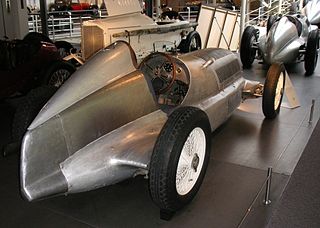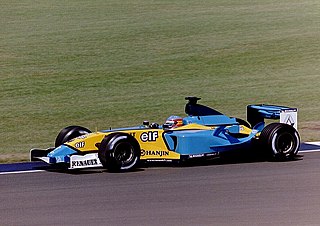McLaren Racing Limited is a British motor racing team based at the McLaren Technology Centre in Woking, Surrey, England. The team is a subsidiary of the McLaren Group, which owns a majority of the team. McLaren is best known as a Formula One chassis constructor, the second-oldest active team and the second-most successful Formula One team after Ferrari, having won 189 races, 12 Drivers' Championships, and nine Constructors' Championships. McLaren also has a history in American open wheel racing as both an entrant and a chassis constructor, and has won the Canadian-American Challenge Cup (Can-Am) sports car racing championship. McLaren is one of only three constructors, and the only team, to complete the Triple Crown of Motorsport.

Marlboro is an American brand of cigarettes owned and manufactured by Philip Morris USA within the United States and by Philip Morris International outside the US. In Canada, a separate product using the Marlboro brand is owned and manufactured by Imperial Tobacco Canada, while the international product is distributed in Canada by a unit of PMI under the name "Rooftop". Marlboro's largest cigarette manufacturing plant is located in Richmond, Virginia.

Silver Arrows is a nickname typically given to silver racing cars with a significant connection to a German car manufacturer. Although the term was coined in 1932, it came into popular usage regarding Germany's dominant Mercedes-Benz and Auto Union Grand Prix motor racing cars between 1934 and 1939. The name was later applied to the Mercedes-Benz Formula One and sports cars in 1954 and 1955, then to the Sauber Group C prototype racing sports cars that raced at Le Mans in the late 1980s as well as the McLaren-Mercedes Formula One cars of the late 1990s and 2000s, and is currently applied to the Mercedes-AMG Petronas F1 cars from 2010 to present.

The 1995 Australian Grand Prix was a Formula One motor race held on 12 November 1995 at the Adelaide Street Circuit, Adelaide. The race, contested over 81 laps, was the seventeenth and final race of the 1995 Formula One season, and the eleventh and last Australian Grand Prix to be held at Adelaide before the event moved to Melbourne the following year. This would also prove to be the last Grand Prix for Mark Blundell, Bertrand Gachot, Roberto Moreno, Taki Inoue, and Karl Wendlinger. This was also the last race for Pacific as they folded at the end of the season.

The 1996 FIA Formula One World Championship was the 50th season of FIA Formula One motor racing. The championship commenced on 10 March and ended on 13 October after sixteen races. Two World Championship titles were awarded, one for Drivers and one for Constructors.

Pedro Paulo Falleiros dos Santos Diniz is a Brazilian former racing driver, businessman and motorsport executive, who competed in Formula One from 1995 to 2000.

Forti Corse, commonly known as Forti, was an Italian motor racing team chiefly known for its brief and unsuccessful involvement in Formula One in the mid-1990s. It was established in the late 1970s and competed in lower formulae for two decades. The team's successes during this period included four Drivers' Championships in Italian Formula Three during the 1980s, and race wins in the International Formula 3000 championship, in which it competed from 1987 to 1994. From 1992, team co-founder Guido Forti developed a relationship with the wealthy Brazilian businessman Abílio dos Santos Diniz that gave Diniz's racing driver son, Pedro, a permanent seat in the team and the outfit a sufficiently high budget to consider entering Formula One.

The Renault R23 was the car with which the Renault team competed in the 2003 Formula One World Championship. It was driven by Italian Jarno Trulli, who was in his second season with the team, and Spaniard Fernando Alonso, who replaced Jenson Button after the Briton left for British American Racing.
Formula One sponsorship liveries have been used since the 1968 season. Before the arrival of sponsorship liveries in 1968 the nationality of the team determined the colour of a car entered by the team, e.g. cars entered by Italian teams were rosso corsa red, cars entered by French teams were bleu de France blue, and cars entered by British teams were British racing green. Major sponsors such as BP, Shell, and Firestone had pulled out of the sport ahead of this season, prompting the Fédération Internationale de l'Automobile to allow unrestricted sponsorship.
Brawn GP was a Formula One constructor which competed in the 2009 Formula One World Championship, with drivers Jenson Button and Rubens Barrichello. The team was formed in 2009 by a management buyout led by Ross Brawn of the Honda Racing F1 Team, after Honda announced their withdrawal from the sport in December 2008 due to the global financial crisis. The team started development of their car in early 2008, when still owned by Honda. For the 2009 season, Honda provided a $100 million budget, while Mercedes provided engines under a customer relationship.

Team Lotus, originally Lotus Racing, was a Malaysian-licensed Formula One racing team and constructor, based in Hingham, Norfolk, UK, which competed during the 2010 and 2011 Formula One seasons. The team scored no championship points in the two years it competed.

The Mercedes MGP W01 was a Formula One motor racing car designed and built by the Mercedes GP Petronas team for the 2010 season and was driven by the returning seven-time World Champion Michael Schumacher and Nico Rosberg.

The McLaren MP4-29 was a Formula One racing car designed and built by McLaren to compete in the 2014 Formula One season. The chassis was designed by Tim Goss, Neil Oatley, Matt Morris, Mark Ingham and Marcin Budkowski and was powered by a customer Mercedes-Benz powertrain. The car was unveiled on 24 January 2014, and was driven by 2009 World Drivers' Champion Jenson Button and debutant Kevin Magnussen, who replaced Sergio Pérez, after he won the 2013 Formula Renault 3.5 Series title.

The Marussia MR03 is a Formula One racing car designed and built by the Marussia F1 Team. It competed for part of the 2014 Formula One season, before the team went into administration in November 2014. Following the team's resurrection as Manor Marussia F1, the car raced as the MR03B after modifications were made to enable it to compete in, and meet the regulations in place for, 2015.

The Red Bull Racing RB16 and RB16B are Formula One racing cars designed and constructed by Red Bull Racing to compete during the 2020 and 2021 Formula One World Championships, respectively. They were powered by Honda's RA620H (2020) and RA621H (2021) power units, being the second and third Red Bull to use the Japanese manufacturer's engines. The drivers for 2020 were Max Verstappen and Alexander Albon, both of whom were retained by the team for a fifth and second season respectively, with Sergio Pérez taking Albon's place for 2021. Albon became the team's test and reserve driver for the 2021 season. The RB16 was planned to make its competitive debut at the 2020 Australian Grand Prix, but this was delayed when the race was cancelled and the next three events in Bahrain, Vietnam and China were postponed in response to the COVID-19 pandemic. The RB16 made its debut at the 2020 Austrian Grand Prix, while the RB16B made its debut at the 2021 Bahrain Grand Prix.

The Alpine A521 is a Formula One car designed by the Alpine F1 Team which competed in the 2021 Formula One World Championship. It was driven by Fernando Alonso, marking his return to the sport, and Esteban Ocon. It was the first to be fielded under the team's Alpine name.

The McLaren MCL36 is a Formula One car that was designed under the lead of James Key and manufactured by McLaren to compete in the 2022 Formula One World Championship. The MCL36 was built to the new 2022 generation of Formula One technical regulations, which were originally intended for introduction in 2021. The car was widely considered to exhibit conventional and unambitious engine packaging. However, it stood out for a unique suspension layout not seen on any Formula One car for nearly ten years, and was noted for its lack of porpoising and good mechanical reliability.

The Haas VF-22 is a Formula One racing car designed and constructed by the Haas F1 Team to compete in the 2022 Formula One World Championship. The VF-22 is Haas' seventh car entry into Formula One. It has been driven by Kevin Magnussen, Mick Schumacher, and Nikita Mazepin, the lattermost who was replaced by Magnussen before the season-opening Bahrain Grand Prix. The car runs on power units supplied by Ferrari.

The Mercedes-AMG F1 W13 E Performance, commonly known as the Mercedes W13, is a Formula One racing car designed and constructed by the Mercedes-AMG Petronas Formula One Team to compete in the 2022 Formula One World Championship.

The McLaren MCL60 is a Formula One car designed and constructed by McLaren, initially under the direction of James Key, to compete in the 2023 Formula One World Championship.

















